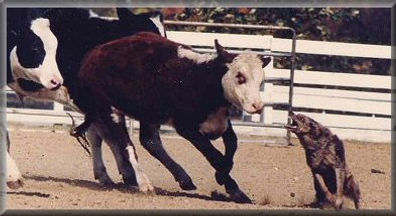

ASCA Hall of Fame Excellent Kennel
Working Aussie Stockdogs
located in Bryan, Texas
TRIAL DOGS AND RANCH DOGS

An interesting fact about dogs in America: The breeds considered useful by American stockmen can be counted on the fingers of one hand! Several years ago The Cattleman ran a series of articles on cattle dogs devoting each issue to one breed. The Australian Shepherd was one of the featured breeds. The New Mexico Stockman ran a Stockdog issue featuring four breeds which included the Aussie. Limousin World ran an article on using stock dogs which included the Aussie along with only three other breeds. An issue of Progressive Farmer had an article on using stock dogs with six breeds mentioned including the Australian Shepherd. The Gulf Coast Cattleman ran an article on training and used an Aussie on the cover..
Many years ago ASCA named its working program the “Stock Dog Program”. Titles earned have always been referred to as “Stock dog titles” or “working titles”. The AKC uses the term “Herding” to refer to their “Herding Group” which was created for dogs with a past history of working livestock. Their program is called a “Herding program”. The term “herding dog” is used to refer to many breeds having no value in the real livestock world.
What difference do words make? Breeds like the Australian Shepherd who are being used on practical livestock operations across America do herd but, more importantly, they WORK. If the Australian Shepherd is to survive as a real life working ranch dog, he will have to be the kind of dog perceived by stockmen as a WORKER. ASCA made a sound decision with their use of terminology taken right from the stockman’s vocabulary.
ASCA keeps records of trial titles to support an individual dog’s ability. The greatest ranch dog in the world is only known to a small group in his local area. What is expected of a ranch dog compared to a trial dog? A trial is an exhibition of natural talent of the dogs combined with training. A dog who is told to go to the left and who goes to the right will be penalized for lack of training. A dog who is told to down or stay but who barely hesitates and goes on will be scored as not obeying a command. When a trial dog is in training, a great deal of time must be spent on perfecting his direction and immediate response to commands. It is a precision game with pretty style also important. Just as fancy footwork and pretty moves will win a cutting horse contest, the same goes for dog trials. The handler is out there for one reason only: To make the dog look good while doing the task assigned.
What is the rancher there for? He is there to get the stock worked in the most efficient way possible. The dog is there to help him in that goal. The stockman’s priority is the task, certainly not the dog. If he sends the dog around the stock to stop them, it seldom matters which way the dog goes. The goal is to stop the stock and turn them back. How fancy the dog looks is irrelevant. A dog who does not have the power to confront and control his cattle is useless. A dog who has to be told every move to make is of little use to the man who is often trying to be in ten places at once himself. The dog better instinctively be in the right place most of the time.
In a trial arena, it is a cardinal sin for the dog to split the stock to get to the other side. In a 100 acre pasture with cattle running off toward a brushy creek bed, the stockman doesn’t care how the dog gets to the head of the ones breaking away. He only needs the dog to possess the power and ability to stop them before they are impossible to round up again. Consequently the ranch dog develops his abilities geared toward end results and not the correctness of how it was done.
The time a trial trainer would take working through the dog’s problems to perfect his work is not available to most ranchers. Most useful ranch dogs got that way because they possess enormous amounts of natural instinct to control stock. Most ranch dogs would benefit by some formal training, but they seldom get it. Many ranchers who do purchase a well trained dog find themselves only using the very basic commands.
Trials are to showcase and identify the best working bloodlines and individuals. The intent is for anyone needing a working dog to be able to base their selection on trial results and titles to identify natural talent. However, natural talent can be overshadowed by training and showmanship. A mediocre individual can become a big name with proper training and promotion whether it be musicians, politicians, cutting horses and, yes, stock dogs. This is not unique to the Aussie world nor even to dogs. When it gets down to the whelping box, all that matters is the instinct the parents were born with. The pups will be born with all the genetic potential they will ever have and do not inherit their parents’ titles.
